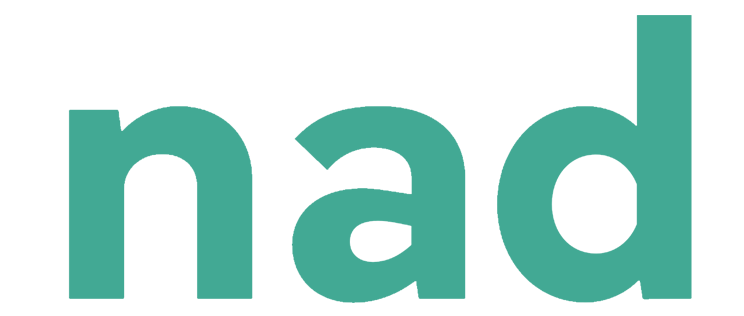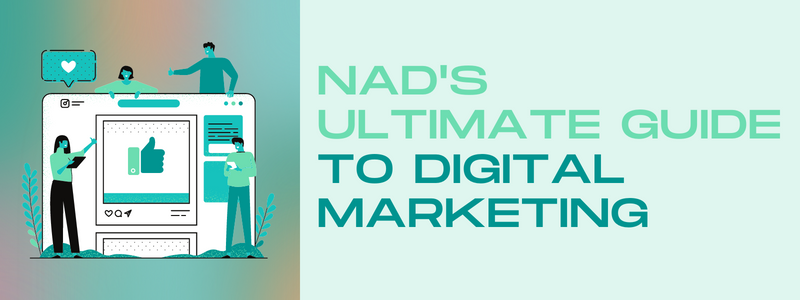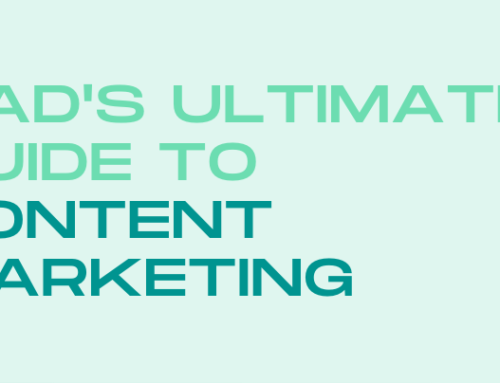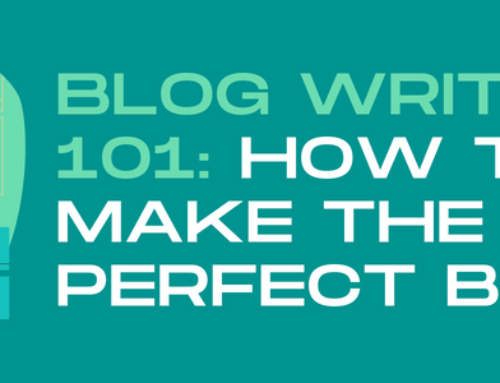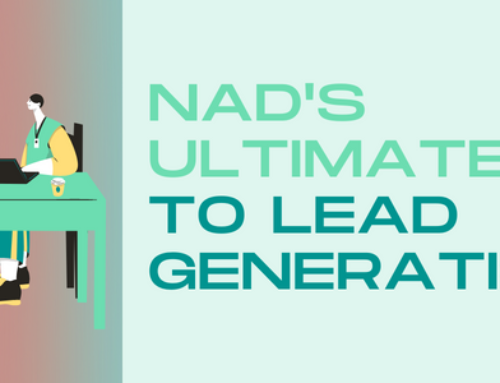Digital marketing is one of the most important aspects of running a successful business in today’s world. The widespread use of the internet and the ever-growing dependence on digital devices has transformed the way businesses market themselves and how social media management agencies in the Philippines promote their clients on social platforms.
To stay competitive and reach the widest possible audience, brands must have a strong digital marketing strategy and make themselves available to consumers at any given time.
That’s why if you’re still not online by now, you’re missing out on a lot of business opportunities that digital marketing offers, specifically ones that will propel your company even further.
Fortunately, it’s still not too late for you—or for any business out there that wants to leverage its digital presence for marketing. In this ultimate guide for digital marketing, you’ll know just how!
Let’s begin by defining digital marketing!
What is Digital Marketing?
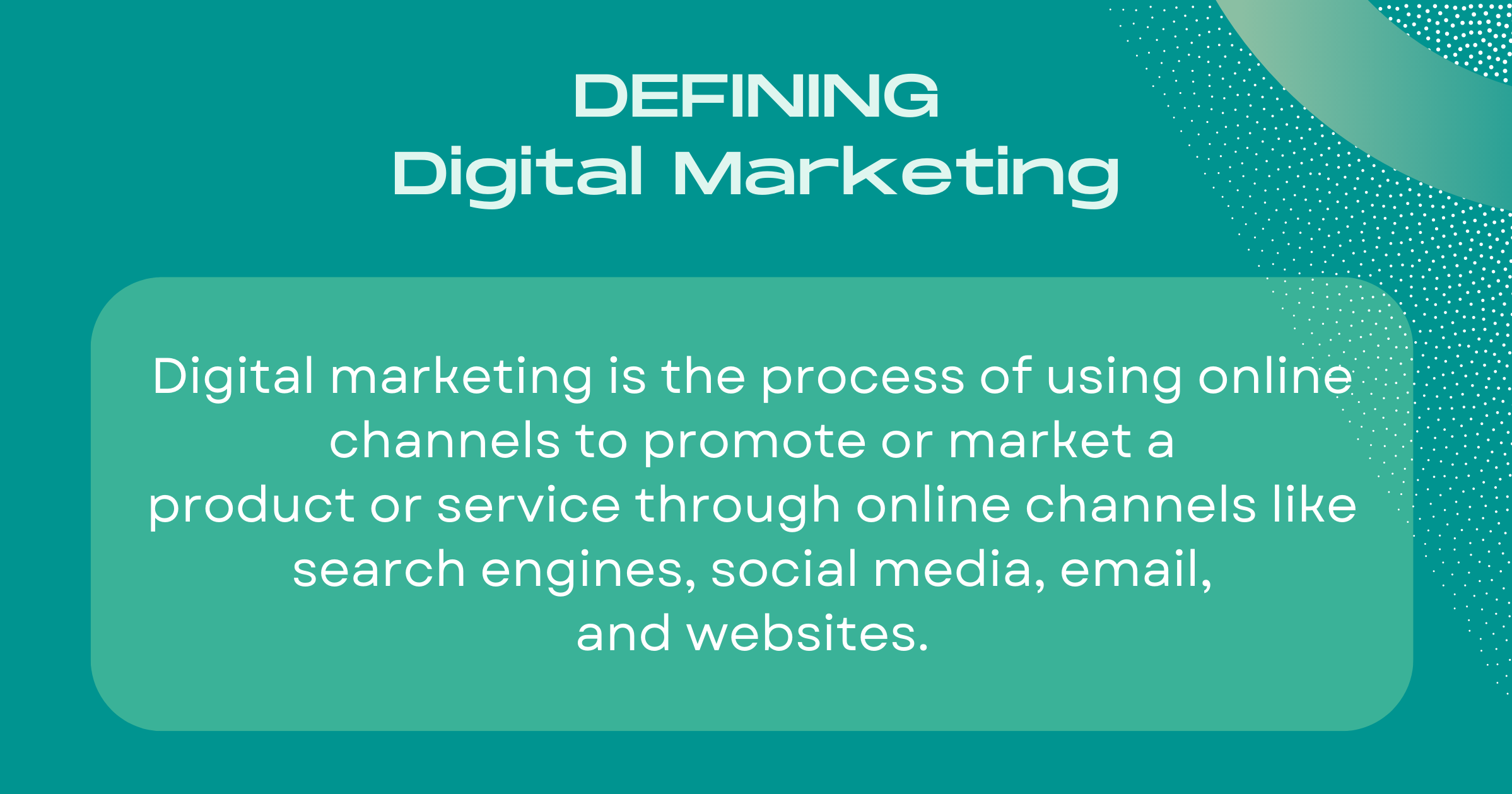
Digital marketing is the process of using online channels to promote or market a product or service through online channels like search engines, social media, email, and websites.
This process uses a variety of tools and strategies to help a business reach its target audience.
In today’s digital era, digital marketing is important for businesses of all sizes since it allows businesses to reach a larger audience with less money spent compared to traditional marketing methods. Apart from that, it provides businesses with a way to track and measure results more accurately.
When done correctly, digital marketing can be a powerful tool to help grow a business. However, it is important to remember that it takes time and effort to create a successful digital marketing campaign. It is also important to continuously test and tweak your strategies as needed to ensure that you are reaching your target audience and achieving your desired results.
Why Is Digital Marketing A Must?
For starters, the internet is practically everywhere. Gone are the days when a business could survive by relying on brick-and-mortar locations and print marketing alone. To remain ever-relevant, businesses need to be visible where their customers are spending the majority of their time: online.
Digital marketing levels the playing field. It’s easier and more cost-effective for small businesses to create a digital marketing strategy than it is to launch a traditional marketing campaign. You no longer need a large budget or a team of experts to create a well-executed marketing plan.
Another selling point for digital marketing is the ability to track data and measure results in real-time. This is a huge advantage over traditional marketing techniques, which can be difficult to measure.
With digital marketing, you can track how many people view your website, how long they stay on your site, what content they’re interested in, and which products they purchase. This data can help you adjust your marketing strategy on the fly to ensure that you’re getting the most bang for your buck.
Finally, digital marketing allows you to personalize your marketing messages. You can segment your audience by demographics, interests, or even behavior, and then create content that appeals to them specifically. This is known as “customer segmentation,” and it’s an incredibly powerful tool that can help you boost your conversion rate and close more sales.
Digital marketing is not a fad or a passing trend. It’s an integral part of doing business in the modern world, and it’s only going to become more important in the years to come. If you haven’t already, now is the time to participate in digital marketing in the Philippines—or any part of the world—and start reaping its benefits!
Benefits of Digital Marketing

- Increased reach: With digital marketing, businesses can communicate with a global audience quickly and easily. There are no geographical boundaries when it comes to digital marketing.
- Greater engagement: Digital marketing techniques allow businesses to achieve a high degree of engagement with their target audience. This is because digital marketing techniques are interactive and allow two-way communication.
- Lower costs: Digital marketing is often more cost-effective than traditional marketing techniques. This is because there are no printing or production costs, and businesses can reach a large audience with minimal effort.
- Increased ROI: Digital marketing is often more effective than traditional marketing, resulting in a higher return on investment. This is because businesses can track the performance of their digital marketing campaigns and make necessary adjustments to maximize their results.
- Increased flexibility: Digital marketing techniques offer a great deal of flexibility, which is ideal for businesses that need to adjust their marketing efforts on the fly. With digital marketing, businesses can easily change their messages and tactics to respond to the needs of their target audience.
- Audience Segmentation and Customization: One of the main advantages of digital marketing is the ability to segment your target audience and then customize your content and message to appeal to that audience. This helps you to better use your marketing budget by targeting those most likely to convert.
- Improved Customer Insights: Digital marketing provides businesses with a wealth of data on their customers. This data can be used to improve customer service, tailor marketing messages, and develop better products. By understanding your customers better, you can provide them with the solutions they are looking for, which will improve customer satisfaction and loyalty.
Digital Marketing vs Traditional Marketing

With the advent of digital technology, marketing has undergone a sea of changes. No longer is marketing about one-way communication, broadcasting a message and hoping it reaches the right people. It is now about engaging customers and prospects in a two-way dialogue, providing them with the information they need to make a purchasing decision.
Digital marketing is interactive and personal, making it more effective at building relationships and trust than traditional marketing. It is also more trackable, so businesses can see which tactics are working and which are not.
Here are some of the key differences between traditional marketing and digital marketing:
- Traditional marketing is about interruption and digital marketing is about engagement.
With traditional marketing, businesses interrupt customers with their messages. They buy ad space on TV, radio, or in print and hope that people will see or hear their message and take action.
Digital marketing, on the other hand, is about engaging customers where they are already spending their time. Businesses connect with prospects and customers through social media, blogs, email, and other online channels. The goal is to provide valuable content that educates, informs, or entertains, with the ultimate goal of driving sales.
- Traditional marketing is one-way, digital marketing is two-way.
With traditional marketing, businesses send out messages and hope they are received. There is no way to track how many people saw or heard the message, or what they did with it.
Digital marketing is two-way, which means businesses can track how many people saw or heard the message, and what they did with it. This allows businesses to see which tactics are working and which are not, and make adjustments accordingly.
- Traditional marketing is about mass reach, digital marketing is about targeted reach.
Traditional marketing is about reaching as many people as possible with a general message. This is often done through mass media like television, radio, and print.
Digital marketing is about reaching people who are most likely to be interested in your product or service. This is done through targeted content, ads, and email marketing.
- Traditional marketing is expensive, digital marketing is cost-effective.
Traditional marketing can be very expensive. Businesses have to pay for ad space, and often need to hire an advertising agency to create and place their ads.
Digital marketing is much more cost-effective. Businesses can reach a large audience without breaking the bank. Additionally, many digital marketing tactics can be done for free or very little cost.
- Traditional marketing is about branding, digital marketing is about sales.
Traditional marketing is about building awareness and creating an emotional connection with a product or service. The goal is to build brand equity so that customers will think of the company first when they are ready to make a purchase.
Digital marketing is about generating leads and sales. The goal is to use targeted content and ads to get people to take action, such as filling out a form or making a purchase.
- Traditional marketing is about awareness, digital marketing is about conversion.
Traditional marketing is about getting people to become aware of a product or service. The goal is to get people to remember the company and its product when they are ready to make a purchase.
Digital marketing is about getting people to take action. The goal is to use targeted content and ads to get people to fill out a form or make a purchase.
- Traditional marketing is about reach, digital marketing is about engagement.
Traditional marketing is about reaching as many people as possible. The goal is to get the company’s message in front of as many people as possible, regardless of whether they are interested in the product or not.
Digital marketing is about engaging people who are already interested in what you have to offer. The goal is to use targeted content and ads to get people to engage with your company, such as signing up for a newsletter or following you on social media.
- Traditional marketing is about messages, digital marketing is about content.
Traditional marketing is about creating messages that businesses want to send out. The goal is to craft a message that will persuade people to buy a product or service.
Digital marketing is about creating content that people want to consume. The goal is to use targeted content to educate, inform, or entertain people, with the ultimate goal of driving sales.
- Traditional marketing is about campaigns, digital marketing is about ongoing efforts.
Traditional marketing is about creating campaigns that run for a set period. The goal is to create a burst of activity that will generate awareness and sales.
Digital marketing is about ongoing efforts to engage customers and prospects. The goal is to create a steady stream of valuable content that will build relationships and trust, and ultimately lead to sales.
- Traditional marketing is about products, digital marketing is about customers.
Traditional marketing is about promoting products and services. The goal is to get people to buy what you’re selling.
Digital marketing is about providing value to customers and prospects. The goal is to use targeted content to educate, inform, or entertain people, with the ultimate goal of driving sales
Types of Digital Marketing

Digital marketing covers a lot of ground. Here are the most common types of digital marketing:
Search engine marketing (SEM): SEM is a type of digital marketing that uses paid search ads to improve a website’s visibility in search engine results pages (SERPs). SEM can be used to target both organic and paid results, and it is an effective way to drive traffic to a website.
Search engine optimization (SEO): SEO is the process of optimizing your website for search engines. The goal is to get your site to rank higher in search results for relevant keywords. If you don’t know what to do, connect with SEO services in the Philippines—they’ll help you better understand the concept and guide you on how to use it for your benefit!
Pay-per-click advertising (PPC): PPC is a type of online advertising where you pay a fee for each click on your ad.
Social media marketing (SMM): SMM is the process of promoting your brand or product on social media platforms like Facebook, Twitter, and LinkedIn.
Content marketing: Content marketing is the creation and distribution of valuable content (such as blog posts, infographics, eBooks, and videos) to attract and retain customers.
If you’re having problems with content marketing, try linking up with a creative agency in the Philippines. For sure, they’ll be able to help you get started!
Email marketing: Email marketing is the process of sending marketing messages (such as newsletters, coupons, and product announcements) to customers via email.
Online PR: Online PR is the process of promoting your company or product through online channels (such as press releases, blog posts, and social media posts).
Affiliate marketing: Affiliate marketing is a type of performance-based marketing where you pay affiliates a commission for each sale or lead they generate.
Display advertising: Display advertising is a type of online advertising that uses banner ads, text ads, and video ads to promote a brand or product.
Mobile marketing: Mobile marketing is the process of promoting your brand or product on mobile devices (such as smartphones and tablets).
Local search marketing: Local search marketing is the process of optimizing your online presence for local search results. The goal is to get your business to appear in the search results when someone searches for a relevant keyword online.
Influencer marketing: Influencer marketing is a type of social media marketing that focuses on using influential people to promote a product or service. Influencers are typically people with a large following on social media, who are considered to be experts in their field.
Influencer marketing is effective because it allows brands to tap into the influence that influencers have over their followers. When an influencer endorses a product or service, their followers are more likely to trust the brand and be interested in what it has to offer.
How to Create an Effective Digital Marketing Strategy
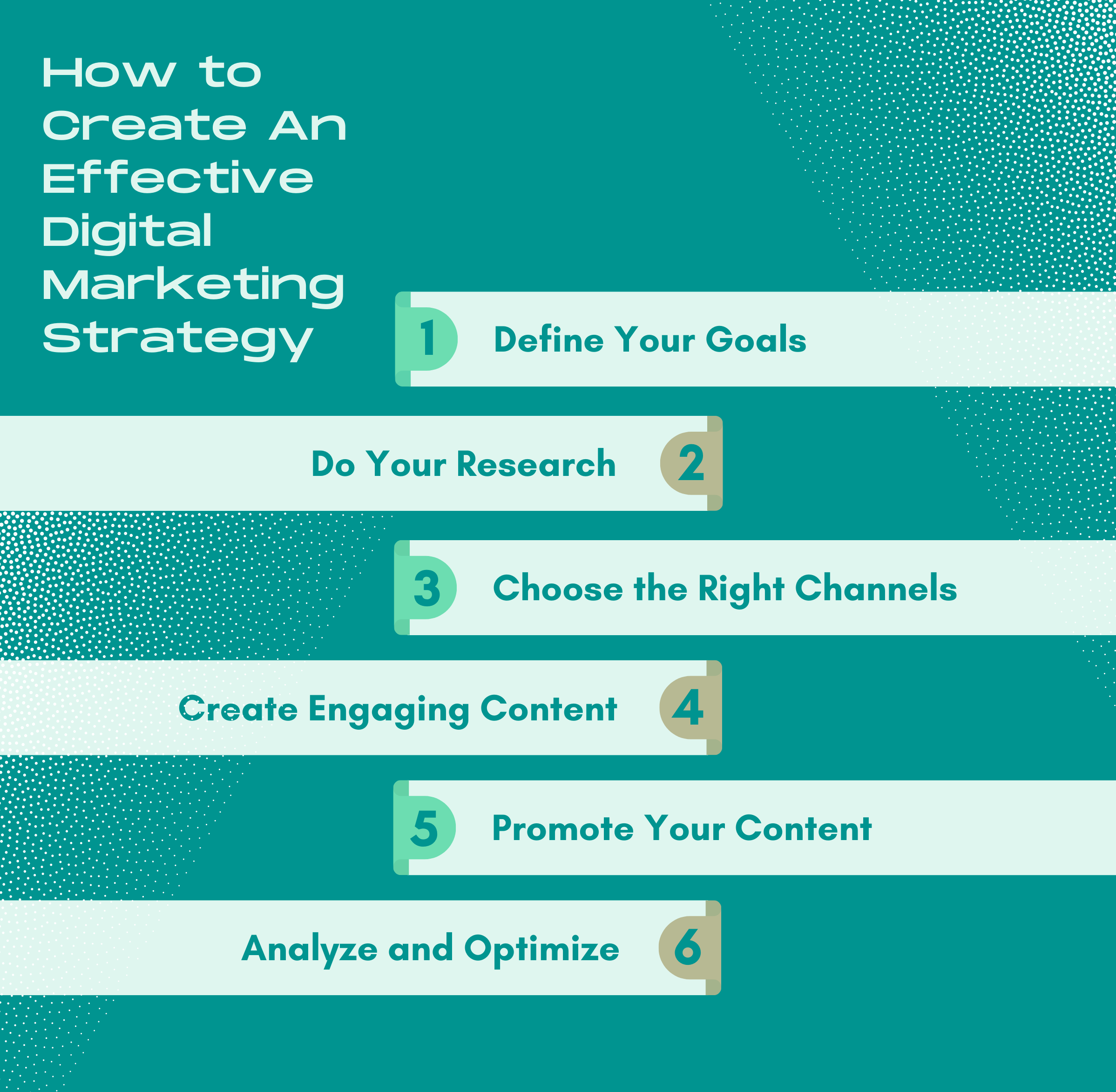
As the world increasingly shifts online, companies are realizing the importance of a digital marketing strategy. By 2021, internet users are expected to reach 7.6 billion – that’s over 96% of the world’s population!
However, with such a large and diverse online market, it can be tricky to know where to start when it comes to your digital marketing strategy.
Here are some of the steps you’ll need to accomplish to create an effective digital marketing strategy:
Step 1. Define your goals
The first step is to identify what you want to achieve with your digital marketing strategy. Are you looking to raise awareness of your brand, increase website traffic, or generate more leads? Once you know your goal, you can start to put together a plan of action to help you achieve it.
Step 2. Do your research
Before you start implementing your digital marketing strategy, it’s essential to do your research and understand your target audience. Who are they? What are their needs and wants? What are their pain points?
Answering these questions will help you create content and messages that resonate with your target audience, and make them more likely to take action.
Step 3. Choose the right channels
There are many digital marketing channels available, so it’s important to choose the most likely to reach your target audience. For example, if you’re targeting young adults, social media platforms like Snapchat and Instagram would be a good choice. If you’re targeting a more mature audience, you might want to focus on LinkedIn or Facebook.
Step 4. Create engaging content
Once you know which channels to focus on, it’s time to start creating engaging content. This could be in the form of blog posts, infographics, videos, or even just simple social media updates. Make sure your content is relevant to your target audience and offers them value. If it’s not, they’re unlikely to pay attention.
Step 5. Promote your content
Just because you’ve created great content doesn’t mean people will automatically see it. You need to actively promote your content on your chosen channels to make sure it’s seen by your target audience. There are several ways to do this, including using paid advertising, social media updates, and email marketing.
Step 6. Analyze and optimize
Finally, it’s important to regularly analyze the performance of your digital marketing strategy and make changes where necessary. Look at your website traffic, social media engagement, and conversions to see how your strategy performs. If you’re not seeing the results you want, don’t be afraid to experiment with different tactics until you find what works.
Final Thoughts
Digital marketing is a fascinating and constantly evolving industry that helps businesses stay competitive in the digital age. By understanding and responding to changes in technology and consumer behavior, businesses can make the most of digital marketing opportunities.
It’s also important to remember that there is no one-size-fits-all approach to digital marketing – your strategy will need to be tailored to your specific customers, market, competitors, products or services, and more.
Although it may seem daunting at first, following some basic steps can help you achieve success with your digital marketing goals. Hopefully, this guide will help you build the digital marketing strategy that fits your brand!
